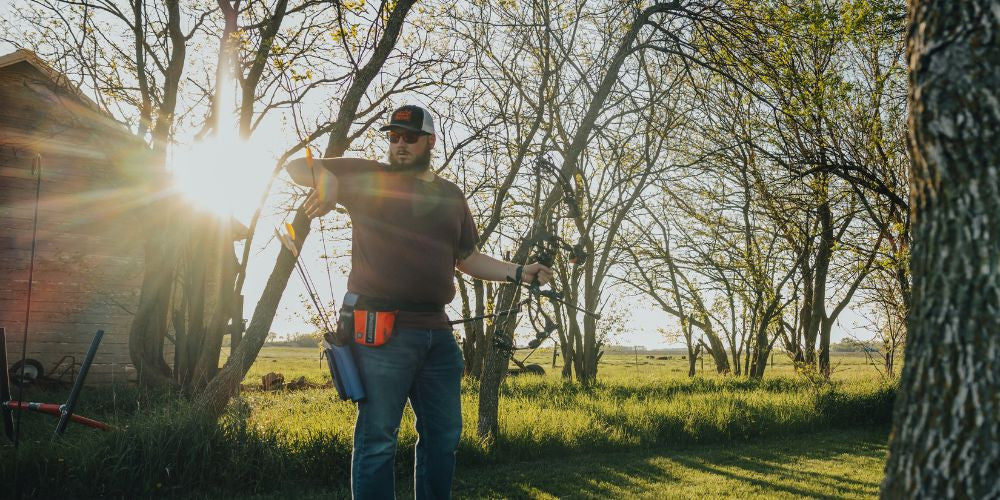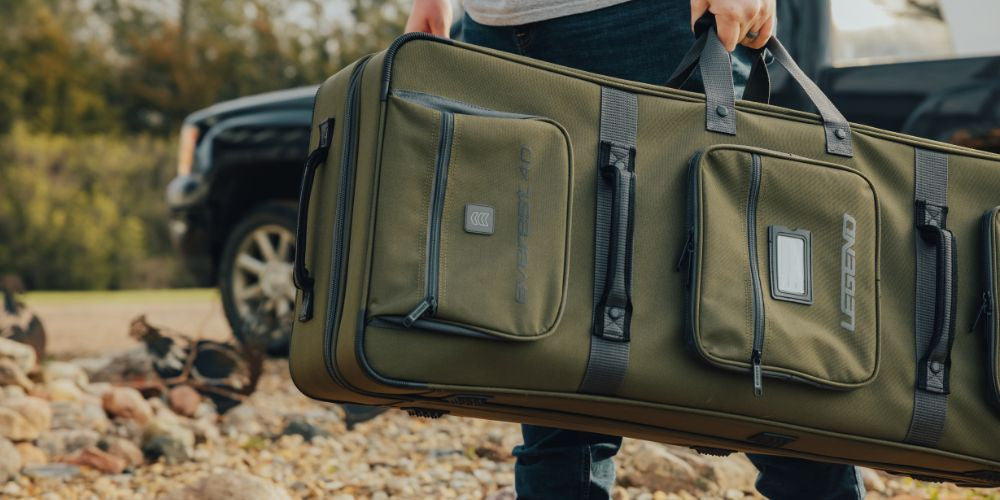Whether you are a beginner or an experienced archer, it is essential to prioritize safety when engaging in this activity. Practicing archery involves the use of a bow and arrow, and it is important to follow specific guidelines to ensure the safety of yourself and those around you. In this article, we will discuss some best practices you must follow in order to ensure your safety in archery.
Proper Equipment To Ensure Archery Safety
Using proper archery equipment is essential for ensuring the safety of fellow archers and others in the vicinity. Here are some key elements to consider when selecting and using proper archery gear:
Choosing the Right Bow and Arrows

When it comes to choosing the right bow and arrows, it is essential to consider several factors. Firstly, the bow should be the right size and draw weight for you. If the bow is too heavy or too light, it can cause discomfort, affect accuracy, and even lead to injuries. You can consult with an experienced archer or a professional archery shop to help you choose the right bow for your skill level and physical ability.
Another factor to consider when choosing the right arrows is their length and weight. Arrows that are too short or too long will not fly straight, and arrows that are too heavy or too light will not fly as far as they should. It is also essential to match the arrow spine (stiffness) to the draw weight of your bow, as a mismatch can result in inconsistent shooting and potentially dangerous situations.
Checking Equipment Condition
Before each shooting session, it is important to inspect your equipment to ensure that it is in good working condition. Check your bow and bow limbs for any visible cracks, twists, or other signs of damage. Inspect the bowstring for signs of fraying or damage, and replace it if necessary. Check arrows for any defects, such as cracks or warps, and discard them if they are damaged.
In addition to visual inspection, it is important to test your equipment by shooting a few practice shots. This will help you identify any issues with your bow or arrows before you start shooting for real. By regularly inspecting and testing your equipment, you can minimize the risk of serious injury and ensure your archery safety.
Protective Gear
Protective gear is essential for archers to prevent injuries and ensure their safety during practice or competition. Here are some of the protective gear that archers should consider:
Arm Guards

Arm guards are essential protective gear that every archer should wear. They are designed to protect your forearm from getting hit by the bowstring when you release the arrow. Without an arm guard, the bowstring can cause painful bruises or cuts on your arm, which can affect your archery performance and increase the risk of accidents.
When choosing an arm guard, look for one that is comfortable, fits well, and covers the entire forearm. Some arm guards are made of leather, while others are made of synthetic materials. It is important to choose a material that suits your needs and preferences.
Finger Tabs or Gloves
Another piece of protective gear that can help prevent archery injuries is a finger tab or glove. These are designed to protect your fingers from getting pinched or cut by the bowstring when you release the arrow. Finger tabs are usually made of leather or synthetic materials and are worn on the first three fingers of your drawing hand. Gloves, on the other hand, cover the entire hand and provide additional protection.
When choosing a finger tab or glove, look for one that is comfortable, fits well, and provides a good grip on the bowstring. Some finger tabs have additional features, such as adjustable finger separators or finger guards, that can enhance your shooting experience.
Chest Guards
Chest guards are optional protective gear that can protect your chest and stomach from the bowstring when you release the arrow. They are especially useful for female archers or those with larger chests, as the bowstring can cause painful bruises or even lead to serious injuries. Chest guards are usually made of lightweight materials, such as nylon or mesh, and are worn over your clothing.
When choosing a chest guard, look for one that fits well and provides adequate protection. Some chest guards have adjustable straps that allow you to customize the fit, while others are designed to be worn over or under your clothing. It is important to choose a chest guard that is comfortable and does not interfere with your shooting form.
Archery Safety On The Shooting Range

Establishing a Safe Shooting Range
Establishing a safe shooting range is essential for maintaining the safety of archers, spectators, and others who may be in the vicinity. Here are some safety measures to put in place when establishing a safe shooting range:
Location
The location is a critical consideration when establishing archery ranges. You should ensure that the range is located in a safe and secure area, away from any residential areas, public roads, or other high-traffic areas. It is also important to ensure that the range has a clear field of vision, with no obstructions that could interfere with archers' shots.
Target Area
The target area is where archers will aim their arrows. The target area should be positioned at a safe distance from the shooting line to prevent any accidents or injuries. The distance will vary depending on the type of archery being practiced, but generally, a minimum distance of 20 yards is recommended for recreational archery.
Backstop

A backstop is a barrier that is positioned behind the target to stop any arrows that may miss the target or pass through it. The backstop should be strong enough to prevent arrows from passing through and should be positioned at a safe distance behind the targets.
Shooting Line
The shooting line is also referred to as the firing line and refers to the area from which archers will shoot their arrows. The firing line should be clearly marked and positioned at a safe distance from the targets. The shooting line should also be clearly marked with a visible line or barrier to ensure that archers do not cross it while others are shooting.
Safety Gear
Archers should always wear appropriate safety gear, including an arm guard, finger tab or glove, and sturdy shoes for safety. Spectators should also be required to wear appropriate archery safety gear, including ear and eye protection, to prevent injuries from flying debris or stray arrows.
Emergency Procedures
In the event of an emergency, it is important to have established procedures in place to ensure the safety of everyone at the shooting range. This may include designating a first aid area, establishing clear communication channels, and having emergency medical services on standby.
Shooting Range Etiquette
Shooting range etiquette refers to the set of guidelines and practices that archers should follow when shooting at a range. Following proper etiquette is essential for maintaining a safe and respectful environment, preventing accidents, and promoting good sportsmanship. Here are some of the key elements of shooting range etiquette:
Waiting Your Turn
When shooting with a group, it is important to wait your turn and allow everyone to shoot before retrieving your arrows. This is not only a matter of courtesy, but it also helps prevent accidents. When retrieving your arrows, wait until everyone has finished shooting and has returned behind the shooting line before crossing the line to collect your arrows.
Keeping a Safe Distance
When not shooting, it is important to stay behind the shooting line and keep a safe distance from the shooting area. This helps prevent accidents and ensures that everyone is aware of their surroundings. If you need to move forward to retrieve arrows or make adjustments to your equipment, do so only when everyone is behind the shooting line and has stopped shooting.
Communicating with Others
Communication is key when shooting at a range. Let others know when you are going to shoot or retrieve your arrows by calling out "Clear to Shoot" or "Clear to Retrieve." This lets everyone know that it is safe to move forward or shoot. Only fire or have your arrow aimed when you.ve being cleared to shoot. If someone is in the process of shooting, wait until they have finished before communicating.
Respecting Others' Equipment
It is important to respect other people's equipment and not touch or adjust it without their permission. This helps prevent accidents and ensures that everyone's equipment is functioning properly. If you notice that someone's equipment is malfunctioning or unsafe, bring it to their attention in a polite and respectful manner.
Following the Rules
Every shooting range has its own set of archery safety rules and regulations. Make sure to familiarize yourself with these rules before shooting and follow them at all times. Rules may include restrictions on the types of equipment that can be used, the distance between shooting stations, or the use of cell phones or other distractions. By following the rules, you help ensure the safety of everyone at the range and show respect for the facility and other archers.
Archery Safety - Proper Shooting Technique

Proper shooting technique is critical for archers to achieve consistent accuracy and ensure archery safety. Here are the key elements of proper shooting technique:
Maintaining Proper Form
Maintaining proper form is essential to ensure accurate shooting and minimize the risk of serious archery injury. When shooting, stand with your feet shoulder-width apart and perpendicular to the target. Keep your shoulders relaxed and square to the target, and draw the bow string back to your anchor point. Your anchor point should be consistent, and you should release the bow string smoothly and without jerking.
It is important to keep your bow arm straight and stable throughout the shot and to avoid twisting your body or leaning to one side. This can affect your accuracy and increase the risk of injury.
Staying Focused
Staying focused is also essential when shooting. Avoid distractions, such as talking or checking your phone, and maintain a clear and focused mind. This will help you stay in control and make accurate shots.
Knowing Your Limits
Knowing your limits is also important when shooting. Do not attempt shots that are beyond your skill level, and do not push yourself too hard. This can lead to fatigue, discomfort, and even injury. Start with easy shots and gradually increase the difficulty as you improve your skills.
Conclusion
Archery can be a fun and rewarding activity, but it is essential to prioritize safety at all times. By following these best practices, you can minimize the risk of accidents and ensure your safety when engaging in this sport. Remember to always use proper archery equipment, wear protective gear, follow shooting range safety guidelines, and maintain proper shooting technique. With these practices in mind, you can enjoy the sport of archery safely and responsibly.
 cust@legendarchery.com
cust@legendarchery.com 302 503 5767
302 503 5767 Whitestown, In 47075
Whitestown, In 47075




